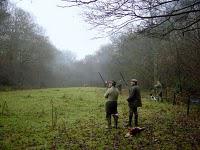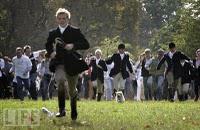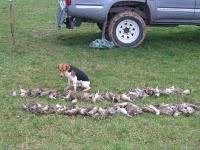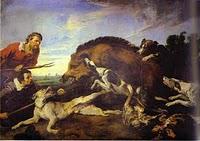 I realize this post is late for the Glorious Twelfth, but I think most people's minds were still on the riots at that time instead of grouse shooting.
I realize this post is late for the Glorious Twelfth, but I think most people's minds were still on the riots at that time instead of grouse shooting.
For the most part, hunting has been the pastime of the landowning classes and royalty--even with the popularization of the sport in the US. Two good reasons for this--they have the land and they have the time. But, I am not talking about using firearms to hunt.
As hunting moved from a subsistence activity to a social one, two trends emerged. One was that of the specialist hunter with special training and equipment. The other was the emergence of hunting as a 'sport' for those of an upper social class. The meaning of the word "game" in middle English evolved to include an animal which is hunted. As game became more of a luxury than a necessity, the stylised pursuit of it also became a luxury. Dangerous hunting, such as for lions or wild boars, often done on horseback or from a chariot, had a function similar to tournaments and manly sports. Hunting was considered to be an honourable, somewhat competitive pastime to help the aristocracy practice skills of war in times of peace.
One of the hunting methods which requires a firearm is also called stalking where one follows signs and trails of game (usually deer). The hunters slowly walk along trails persuing for game.
There are also driven shoots, where beaters are employed to walk through woods and over moors or fields, dependent on the quarry and time of year and drive game towards a line of 8 - 10 standing guns standing about 50 or 60 metres apart. The guns will have paid in the region of £25 per bird for pheasants and much more for grouse, and the total bag (number of birds shot) will be anywhere between 80 and 400, again dependent on the budget and quarry.
The day may be very formal, and the head gamekeeper or a shoot captain will oversee p
 roceedings and great emphasis is placed on safety. Pickers-up with dogs are also employed to make sure all shot or wounded game is collected. On estates holding driven shoots, large numbers of pheasants, partridge and duck, but not grouse, are reared and released to provide sufficient numbers of game. Grouse cannot be reared intensively but the heather moorland where they live is intensively managed to maximise numbers.
roceedings and great emphasis is placed on safety. Pickers-up with dogs are also employed to make sure all shot or wounded game is collected. On estates holding driven shoots, large numbers of pheasants, partridge and duck, but not grouse, are reared and released to provide sufficient numbers of game. Grouse cannot be reared intensively but the heather moorland where they live is intensively managed to maximise numbers.
Rough shooting, where several guns walk through a woodland, moor or field and shoot the birds their dogs put up, is increasingly popular. It is less formal and may be funded by several people grouping together to form a "syndicate", paying a certain amount each year towards game and habitat maintenance.
Wildfowling is often a lonely and uncomfortable sport. A single gun sits in pursuit of wildfowl by a body of water, or on the coastal foreshore, often at dawn or dusk, and waits for birds to "flight" in. This is sometimes undertaken in total darkness or by the light of the moon. Duck are also shot on the two former methods.
The phrase hunting, however, has also refers to the traditional practice of chasing animals with packs
 of hounds, now illegal under the Hunting Act 2004. In the late nineteenth and twentieth centuries, there were several horse based hunt clubs in England.
of hounds, now illegal under the Hunting Act 2004. In the late nineteenth and twentieth centuries, there were several horse based hunt clubs in England.
One doesn't need horses to hunt, as there is also beagling. Beagling is the hunting of hares, rabbits, and occasionally foxes with beagles. A beagle pack (20-40 hounds) is usually followed on foot. However, there is one pack of beagles in the U.S. which are distinguished as being the only hunting pack to hunt fox and be followed on horseback. Beagling is often enjoyed by 'retired' fox hunters who have either sustained too many injuries or lost the agility to ride horseback, or who enjoy the outdoors and the camaraderie of the hunt. It was also traditionally a way for young men to learn how to handle hounds on a smaller scale before they went on to hunt with foxhounds, and many famous public schools and universities had a pack of beagles.
The picture above is of the Connaught Square Squirrel Hunt (Laci and I are members of this hunt) which is the world’s only urban hunt and the first hunt club founded after the 2004 UK hunting ban. The CSSH drag-hunt squirrels across Hyde Park, meaning that one member runs through the park with an old sock on a string, and the dog chases after this pretend 'squirrel.' Close on the paws of the dog are the hundred or so sweating followers, trying to keep up. After no more than thirty seconds the dog catches the sock, has a good chew, and after a short break for ev
 eryone to catch their breath, it all starts again.
eryone to catch their breath, it all starts again.
Ratting was a more democratised version of beagling and was related to rat baiting (one needs rats to bait). Ratters would collect, or kill, rats and other rodents with small dogs such as Jack Russels or Chinese Cresteds. Although, ratting dogs were typically working terrier breeds, which included, but were not limited to, the Bull and Terrier, Bull Terrier, Fox Terrier, Jack Russell Terrier, Rat Terrier, Manchester Terrier, Yorkshire Terrier and Staffordshire Bull Terrier.
Traditional Boar hunts were seen as a test of bravery. Unlike modern hunts, boars were chased on foot or horseback with a specialized boar spear. The boar spear was sometimes fitted with a cross guard
 to stop the enraged animal driving its pierced body further down the shaft in order to attack its killer before dying. Dogs are used in the hunt to physically take hold of the boar, typically seizing the base of the boar's ear. Once the catch dogs have physical control of the boar, they will hold it down by the head indefinitely until the hunter arrives. The hunter then comes in from behind the boar, and dispatches the boar with a knife or spear.
to stop the enraged animal driving its pierced body further down the shaft in order to attack its killer before dying. Dogs are used in the hunt to physically take hold of the boar, typically seizing the base of the boar's ear. Once the catch dogs have physical control of the boar, they will hold it down by the head indefinitely until the hunter arrives. The hunter then comes in from behind the boar, and dispatches the boar with a knife or spear.
Hunting has been democratised in the US, but it still requires land where one is able to hunt. One aspect of this democratisation is that traditional methods of hunting have been replaced by the use of firearms. Additionally, landowners can bar hunters and shooters from their land. That leads to the question of whether the sport is truly popular if one has to have both the time and the land to hunt. State governments allow for hunting, but how long will that practice last?
